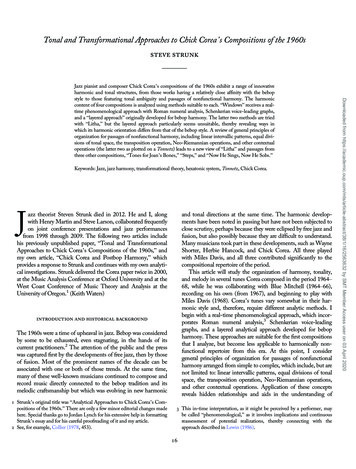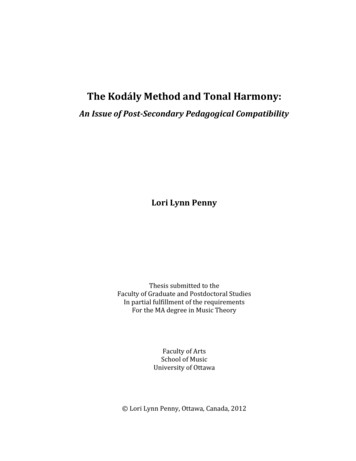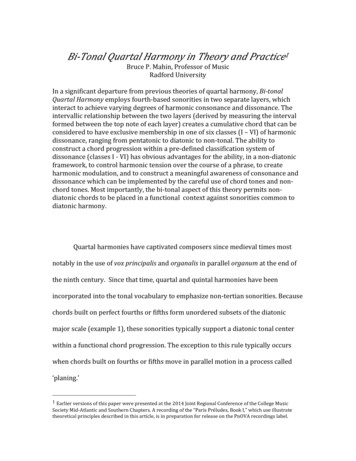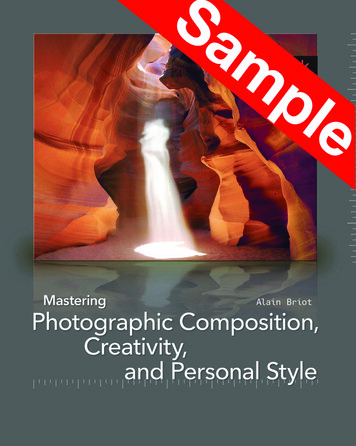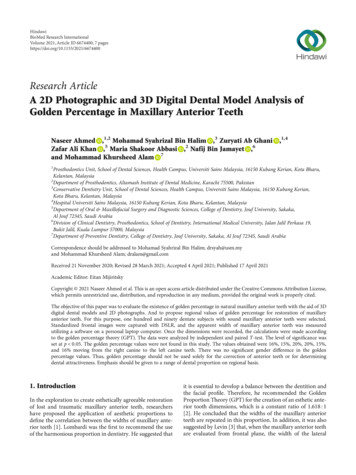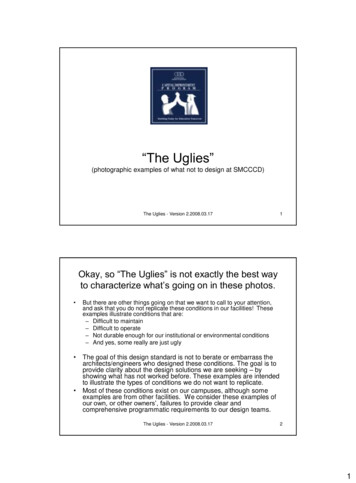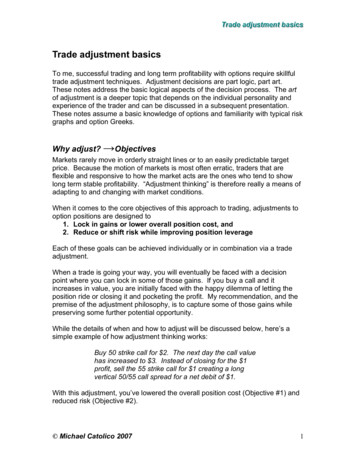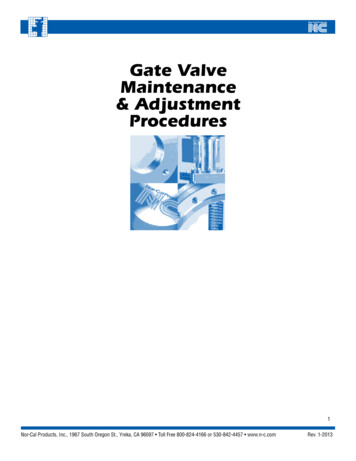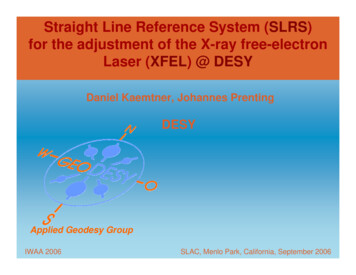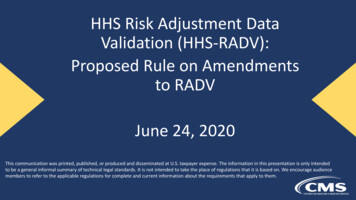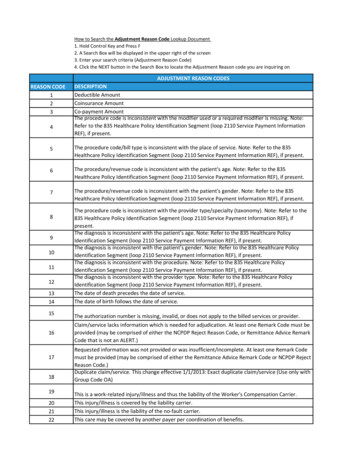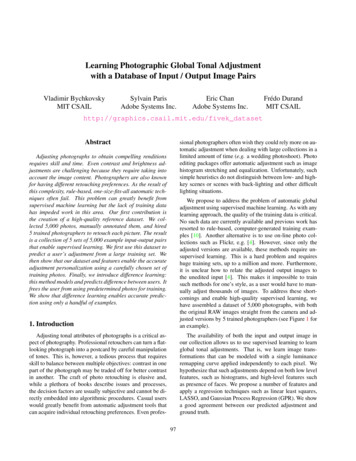
Transcription
Learning Photographic Global Tonal Adjustmentwith a Database of Input / Output Image PairsVladimir BychkovskyMIT CSAILSylvain ParisAdobe Systems Inc.Eric ChanAdobe Systems Inc.Frédo DurandMIT CSAILhttp://graphics.csail.mit.edu/fivek datasetAbstractsional photographers often wish they could rely more on automatic adjustment when dealing with large collections in alimited amount of time (e.g. a wedding photoshoot). Photoediting packages offer automatic adjustment such as imagehistogram stretching and equalization. Unfortunately, suchsimple heuristics do not distinguish between low- and highkey scenes or scenes with back-lighting and other difficultlighting situations.Adjusting photographs to obtain compelling renditionsrequires skill and time. Even contrast and brightness adjustments are challenging because they require taking intoaccount the image content. Photographers are also knownfor having different retouching preferences. As the result ofthis complexity, rule-based, one-size-fits-all automatic techniques often fail. This problem can greatly benefit fromsupervised machine learning but the lack of training datahas impeded work in this area. Our first contribution isthe creation of a high-quality reference dataset. We collected 5,000 photos, manually annotated them, and hired5 trained photographers to retouch each picture. The resultis a collection of 5 sets of 5,000 example input-output pairsthat enable supervised learning. We first use this dataset topredict a user’s adjustment from a large training set. Wethen show that our dataset and features enable the accurateadjustment personalization using a carefully chosen set oftraining photos. Finally, we introduce difference learning:this method models and predicts difference between users. Itfrees the user from using predetermined photos for training.We show that difference learning enables accurate prediction using only a handful of examples.1. IntroductionWe propose to address the problem of automatic globaladjustment using supervised machine learning. As with anylearning approach, the quality of the training data is critical.No such data are currently available and previous work hasresorted to rule-based, computer-generated training examples [10]. Another alternative is to use on-line photo collections such as Flickr, e.g. [4]. However, since only theadjusted versions are available, these methods require unsupervised learning. This is a hard problem and requireshuge training sets, up to a million and more. Furthermore,it is unclear how to relate the adjusted output images tothe unedited input [4]. This makes it impossible to trainsuch methods for one’s style, as a user would have to manually adjust thousands of images. To address these shortcomings and enable high-quality supervised learning, wehave assembled a dataset of 5,000 photographs, with boththe original RAW images straight from the camera and adjusted versions by 5 trained photographers (see Figure 1 foran example).Adjusting tonal attributes of photographs is a critical aspect of photography. Professional retouchers can turn a flatlooking photograph into a postcard by careful manipulationof tones. This is, however, a tedious process that requiresskill to balance between multiple objectives: contrast in onepart of the photograph may be traded off for better contrastin another. The craft of photo retouching is elusive and,while a plethora of books describe issues and processes,the decision factors are usually subjective and cannot be directly embedded into algorithmic procedures. Casual userswould greatly benefit from automatic adjustment tools thatcan acquire individual retouching preferences. Even profes-The availability of both the input and output image inour collection allows us to use supervised learning to learnglobal tonal adjustments. That is, we learn image transformations that can be modeled with a single luminanceremapping curve applied independently to each pixel. Wehypothesize that such adjustments depend on both low levelfeatures, such as histograms, and high-level features suchas presence of faces. We propose a number of features andapply a regression techniques such as linear least squares,LASSO, and Gaussian Process Regression (GPR). We showa good agreement between our predicted adjustment andground truth.97
While a brute-force supervised learning approach is convenient for learning a single “neutral” rendition corresponding to one of the photographers hired to retouch our dataset,it necessitates a large investment in retouching thousandsof photographs. In order to accommodate a greater varietyof styles without requiring thousands of examples for eachstyle, we build on Kang et al. [10]: We seek to select a smallnumber of photographs so that adjustments on new photoscan be best predicted from this reduced training set. A userthen only needs to retouch this small set of training photographs to personalize future adjustments. We show thatour dataset together with our new features provide significant performance improvement over previous work.The above-mentioned approach still requires users toretouch a predefined set of images that come from thedatabase, as opposed to their own photos. We want to alleviate this and learn the adjustments of a user directly fromarbitrary photographs. We hypothesize that there is a correlation between users. We use a two-step approach, wherethe prediction from our neutral style trained on thousands ofimages is combined with a method that learns on-the-fly thedifference between neutral and the new style of adjustment.The learning is further helped by the use of a covariancematrix learned on the large database. We show that thiscan enable good predictions using only a handful of userprovided adjustments.modeling using supervised machine learning.Tone mapping algorithms [15] compress the tonal rangeof HDR images. By default, these techniques produce ageneric rendition. Although the achieved look can be controlled by parameters, these are set by the user. Bae et al. [3]and Hertzmann et al. [9] adjust photos using a model provided by the user. In comparison, we focus on fully automatic adjustment.Several methods, e.g. [5, 12], have been proposed to assess the visual quality of photos. However, using these techniques in the context of adjustment would be nontrivial because these methods strongly rely on the image content todiscriminate the good images from the bad ones. In comparison, an adjustment modifies the rendition while the contentis fixed. From this perspective, our dataset offers an opportunity to revisit the style-vs-content problem studied byTenenbaum and Freeman [17].Gehler et al. [7] have shown that supervised learning canbe a successful approach to inferring the color of the lightthat illuminates a scene. Our work shares the machinelearning approach with this paper but focuses on tonal adjustments.Dale et al. [4] restore damaged photos using a corpusof images downloaded from Internet. The dataset is hugebut only the final rendition is available. In comparison, ourimages are not damaged and we seek to improve their rendition, not repair problems such as over- and under-exposure.More importantly, our dataset provides both input and output images.Kang et al. [10] personalize the output of an automaticadjustment method by using a small but predetermined setof examples from their collection. Given a new image, theirapproach copies the adjustment of nearest user-retouchedexample. To determine the similarity metric between photos, Kang et al. use metric learning and sensor placement [11]. However, metric learning requires a large training set to be effective. On that issue, Kang et al. note that “itis infeasible for any user to find these parameters manuallybecause no large collection of photos including untouchedinput and retouched versions is available,” which motivatestheir generating synthetic training data using gray-highlightwhite balance and histogram stretching. In contrast, we collected adjustments from trained photographers. Also, enable users to train the system without a predetermined setof examples by learning the difference between photographers. Thus, we leverage our dataset while freeing the userfrom working on training images.1.1. Related WorkPhoto editing software such as Adobe Photoshop enablesarbitrary pixel modifications with a plethora of tools. Incontrast, we want to focus on the fundamentals of photo rendition, and in particular the adjustment of brightness, contrast, and a tonal response curve in the spirit of the zonesystem [1, 2]. These are the type of edits that motivatedlighter-weight packages such as Adobe Lightroom and Apple Aperture that provide simpler, parametric control overphoto renditions and enable a much faster workflow. Thesepackages offer automatic photo adjustment tools but unfortunately, little is known about the actual techniques used.As far as we can tell, many of them apply simple rules suchas fixing the black and white points of the image to the darkest and brightest pixels. Although this may work on simplecases, these approaches fail on more complex examples forwhich a photographer would apply more sophisticated modifications.There are numerous books about image adjustment,e.g. [1, 2, 6, 13]. However, their suggestions cannot be directly converted into an algorithm. The guidelines rarelyprovide actual values and often rely on the subjective judgment of the viewer. The recommendations can also be contradictory when several elements are present in a photo. Toadjust images, photographers make decisions and compromises. Our dataset provides numerous examples of thesecomplex adjustments and thereby enables their systematic1.2. ContributionsA reference dataset We have collected 5,000 photos inRAW format and hired 5 trained photographers to retouched each of them by hand. We tagged the photosaccording their content and ran user study to rank thephotographers according to viewers’ preference.98
(a) input(b) Retoucher A(c) Retoucher B(d) Retoucher C(e) Retoucher D(f) Retoucher EFigure 1. On this photo, the retouchers have produced diverse of outputs, from a sunset mood (b) to a day light look (f). There is no singlegood answer and the retoucher’s interpretation plays a significant role in the final result. We argue that supervised machine learning is wellsuited to deal with the difficult task of automatic photo adjustment, and we provide a dataset of reference images that enables this approach.This figure may be better viewed in the electronic version.Global learning We use this dataset for supervised learning. We describe a set of features and labels that enablethe prediction of a user’s adjustment.merically evaluate these points with statistics computed inthe CIE-Lab color space. The difference between the inputphoto and the retouched versions is 5.5 on average and canbe as much as 23.7. And the average difference between theretouched version is 3.3 and the maximum is 23.5. For reference, the difference between white and black in CIE-Labis 100. We also augmented the dataset with tags collectedwith Amazon Mechanical Turk to annotate the content ofthe photos. We also ran a user study in a controlled settingto rank photographers according to users’ preference on asubset of our dataset.We studied the dimensionality of the tone remappingcurves that transform the input image luminance into theadjusted one. We found that the first three principal components explain 99% of the variance of the dataset and thatthe first component alone is responsible for 90% of it. Thisis why we focus our learning on this component.Sensor placement Our dataset enables sensor placement toselect a small set of representative photos. Using adjustments made to these photos by new users we accurately learn preferences of new users.Difference learning We show that predicting the differencebetween two photographers can generate better resultsthan predicting the absolute adjustment directly, andthat it can be used for learning users’ preferences onthe-fly.2. A Dataset of Input-Output PhotographsWe have collected 5,000 photographs taken with SLRcameras by a set of different photographers. They are all inRAW format, i.e., all the information recorded by the camera sensor is available. We have made sure that the photographs cover a broad diversity of scenes, subjects, andlighting conditions. We then hired five photography students in an art school to adjust the tone of the photos. Eachof them retouched all the 5,000 photos using a software dedicated to photo adjustment (Adobe Lightroom) on whichthey were extensively trained. We asked the retouchers toachieve visually pleasing renditions, akin to a postcard. Theretouchers were compensated for their work. A visual inspection reveals that the retouchers made large modifications to the input images. Moreover, their adjustments arenontrivial and often differ significantly among the retouchers. Figure 1 shows an example of this diversity. We nu-3. Learning problem setup3.1. LabelsWe express adjustments as a remapping curve from inputluminance into output luminance, using the CIE-Lab colorspace because it is reasonably perceptually uniform. Thecurve is represented by a spline with 51 uniformly sampledcontrol points. We fit the spline to the pairs of input-outputluminance values in a least-squares sense.We want to avoid bias due to the type of camera used fora photo and the skill of the particular photographer. In particular, different camera metering systems or a user’s manual settings might result in different exposures for a givenscene. This is why we normalize the exposure to the same99
baseline by linearly remapping the luminance values of eachimage so that the minimum is 0 and the maximum 100.We focus on learning the first PCA coefficient of theremapping curves, which is a good approximation to thefull curve (§ 2). At run time, we predict the new adjustmentby reconstructing the full curves and interpolating linearlybetween samples.2D spatial Gaussian to the corresponding pixels. The feature value is the area of the fitted Gaussian divided by thenumber of pixels in the given tone range. We also use thexy coordinates of the center of the Gaussian as a featurerepresenting the coarse spatial distribution of tones.B Faces: People are often the main subject of a photoand their adjustment has priority. We detect faces and compute the following features: intensity percentiles within facial regions (if none, we use the percentiles of the wholeimage), total area, mean xy location, and number of faces.We also experimented with other features such as localhistograms, color distributions, and scene descriptors butthey did not improve the results in our experiments.3.2. FeaturesThe features that we use for learning are motivated byphotographic practice and range from low level descriptionsof luminance distribution to high-level aspects such as facedetection. Before computing features, we resize the imagesso that their long edge is 500 pixels.B Intensity distributions: Photographers commonly relyon the distribution of intensities as depicted by a log-scalehistogram to adjust the tonal balance. We consider the distribution of the log-intensity log(R G B) and computeits mean and its percentiles sampled every 2%. We alsoevaluate the same percentiles on two Gaussian-convolvedversions of the photo (σ 10 and σ 30) to account forthe tonal distributions at larger scales.B Scene brightness: We hypothesize that scenes that aredark vs. bright in the real world might be adjusted differently. We evaluate the scene brightness as: (Ŷ N 2 )/( t ISO) where Ŷ is the median intensity, N is the lens aperture number that is inversely proportional to the apertureradius, t is the exposure duration, and ISO is the sensorgain. This quantity is proportional to the light reaching thecamera sensor and assumes that there is no filter attached.B Equalization curves: Photographers tend to use theentire available intensity range. Histogram equalization is acoarse approximation of this strategy. We compute the corresponding curve, i.e., the cumulative distribution function(CDF) of the image intensities, and project it on the first 5PCA components of the curveB Detail-weighted equalization curves: Detailed regionsoften receive more attention. We represent this by weighting each pixel by the gradient magnitude, and then projectthe weighted CDF onto the first 5 PCA components of thecurve. We estimate the gradients with Gaussian derivativesfor σ 1, σ 100, and σ 200 to account for details atdifferent scales.B Highlight clipping: Managing the amount of highlightthat gets “clipped” is a key aspect of photo retouching. Wecompute the label values that clip the following fraction ofthe image: 1%, 2%, 3%, 5%, 10%, and 15%.B Spatial distributions: The fraction of highlights, midtones, and shadows are key aspects discussed in the photography literature. However, their percentage alone doesnot tell the whole story, and it is important to also considerhow a given tone range is spatially distributed. We split theintensity range in 10 intervals. For each of them, we fit a3.3. Error MetricWe use the L2 metric in the CIE-Lab color space toevaluate the learning results because this space is perceptually uniform. The difference between white and black is100, and distance of 2.3 corresponds to a just-noticeabledifference (JND) [16]. Since we focus on tonal balance,we measure the difference in luminance between the predicted output and the user-adjusted reference. We evaluateour learning methods by splitting our dataset into trainingon 80% dataset and testing on the remaining 20%.4. Learning Automatic AdjustmentWe consider two practical cases. First, we aim for reproducing the adjustment of a single photographer given alarge collection of examples. In the second case, we seekto learn adjustments from a specific user from a small set ofexamples, assuming that we have access to a large collection of examples by another photographer. To validate ourapproach, we compare it to the recent method of Kang etal. [10] because it tackles similar issues and requires onlyminor changes to work on our dataset.4.1. Predicting a User’s AdjustmentIn this scenario, we have a large dataset of examplesfrom a single user and we learn to adjust images similarlyto this photographer. This is useful for a camera or software company to train an automatic adjustment tool. Wetested several regression algorithms: linear regression as asimple baseline, LASSO as a simple and still efficient technique [8], and Gaussian Processes Regression (GPR) as apowerful but computationally more expensive method [14].LASSO performs a linear regression on a sparse subset ofthe input dimensions. We trained it using 5-fold crossvalidation on the training set. GPR has been shown to havegreat abilities to learn complex relationships but is also significantly more expensive in terms of computation. To keepthe running time reasonable, we trained it only on 2,500randomly selected examples.100
Comparison to Metric Learning For comparison, weimplemented a variant of the method by Kang et al. [10]so that it uses our dataset and handles a single user. Weused the user’s adjustments instead of computer-generateddata for learning the metric. We kept sensor placement unchanged, i.e., we select the images that maximize the mutual information with the user’s adjustments. The nearestneighbor step is also unaltered except that we transfer thetonal curve extracted from our data instead of Kang’s parametric curve and white balance.Results We selected Retoucher C for our evaluation because the high ranking in our user study. Using labels fromRetoucher C we compared several options: the mean curveof the training set; the metric learning method using 25 sensors as recommended by the authors of [10]; least-squaresregression (LSR); LASSO set to keep about 50 features; andGPR. The prediction accuracy is report
Photo editing software such as Adobe Photoshop enables arbitrary pixel modifications with a plethora of tools. In contrast, we want to focus on the fundamentals of photo ren-dition, and in particular the adjustment of brightness, con-trast, and a tonal response curve in the spirit of th
